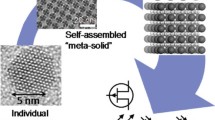Abstract
Self-assembly is a process in which a disordered system of components forms an organized structure or pattern as a consequence of specific, short- and/or long-range interactions among the components themselves. The driving force for self-assembly can be biological, chemical, mechanical, or physical in nature. Self-assembly can occur in all length scales and is a highly promising bottom-up approach to fabricate functional nanoscale to submicrometer materials and devices. Directed assembly can be broadly defined as ordering in the presence of some guidance from a top-down viewpoint such as an external force. Both self-assembly- and directed assembly-based processes offer intriguing possibilities to fabricate devices and systems that are not possible with traditional top-down approaches. Moreover, they provide the potential of finding very interesting and important fundamental new physical phenomena in such ordered materials; for example, in self-assembled three-dimensional (3D) nanocomposites of electromagnetically or electro-optically active materials. Theory, computational modeling, and simulation of self-assembly and directed processes are important to better understand the processes that govern the ordering. In this focus issue of the Journal of Materials Research, a group of papers related to the latest developments in self-assembly and directed assembly of advanced materials are presented. Papers span from a focus on materials synthesis, processing, and characterization, to computational modeling and theoretical understanding of the ordering process.
Similar content being viewed by others
Avoid common mistakes on your manuscript.
This focus issue contains five overview or review papers and 21 invited or contributed papers. Bao and Gupta review recent advances in the field of superparamagnetic nanoparticle self-assembly, with an emphasis on chemical fabrication and on properties and potential applications. Herr provides an overview of directed self-assembly for high volume patterning of nanoelectronic devices with a focus on chemical patterning and graphoepitaxial approaches to block copolymer-based assembly. Davis reviews controlled bottom-up assembly of nanocylinders (including nanotubes, nanorods, and nanowires) into large-area, aligned arrays via liquid crystal assembly. The review focuses on three systems—carbon nanotubes, inorganic nanocylinders, and cellulose nanocrystals. Krishna et al. provide a review of laser-induced self-organization by dewetting of ultrathin metallic films. They review both experimental and theoretical aspects pertaining to this process for producing nanoscale metallic structures. In a related paper in this focus issue, Wu et al. report on the optical properties of Cu–Ni ultrathin nanoparticle films on silicon fabricated via laser dewetting. Yin et al. provide an overview of recent developments in the field of optofluidic, surface-enhanced Raman scattering. Nanostructured optofluidic elements are of interest for many applications and this technique is relevant for characterization of such structures.
Noh et al. report on formation of self-assembled, nanotubular aluminum oxide arrays via hard anodization techniques. The fabricated nanotube arrays were shown to exhibit uniform dimensions and aspect ratios ~1000. Orme et al. report on the use of alumina-silica nanolaminate cross sections to induce order in protein macromolecules. Mizusawa et al. report on fabrication of controlled FePt nanostructures for magnetic storage on self-assembled silica nanoparticles. Tang et al. report on electrostatic self-assembly of nanoparticles onto a silicon substrate patterned with arrays of peaks and valley photoresist structures formed via low-cost patterning techniques. Mittal et al. report on directed assembly of disk-shaped zeolite particles using an external electric field. It was found that the presence of the electric field causes the particles to orient with their major axis parallel to the field direction. Han et al. report on unidirectional patterning of CaF2 nanorod arrays using capillary pressure. The CaF2 nanorods were grown using oblique angle deposition. Ren et al. report on self-assembled crystal growth of NaCl (100) films on self-assembled organic molecules on surfaces. Layer-by-layer molecular self-assembled films are attractive for many device applications. Kanaizuka et al. report on enhanced photocurrent generation in heterostructured films composed of donor-acceptor and donor-insulator networks on indium tin oxide electrodes. Garozzo et al. report on a route for production of large-scale substrates with ordered nanometric patterns of metallic gold nanodots using diblock copolymer self-assembly. Sharma et al. report on templated self-assembly of non-close-packed, binary, colloidal heterostructures. Toth et al. report on a patterning process, which does not require a template and is able to produce Fe2O3 microdots with spatial periodicity. Labukas and Ferguson report on electrochemically directed two-component self-assembled monolayers of gold. Nilsson et al. report on low-temperature synthesis of titania nanoparticles within a Pluronic block copolymer system for direct synthesis of ordered mesoporous crystalline titania.
Self-assembly is also considered to be a promising approach for component integration on a template or in the form of 3D structures at the micron or submicron length scales. Saeedi et al. demonstrate sequential self-assembly of micron-scale components based on light activation. They give examples of four different silicon microcomponents that can be successfully fabricated with yields over 85%.
Self-assembly of organic molecules is important for many devices such as organic field-effect transistors, organic light emitting diodes, and organic photovoltaic cells. Rolczynski et al. report on length-dependent self-assembly of oligothiophene derivatives in thin films. Tange et al. report on self-assembling a photosynthetic dye for organic photovoltaics with high conversion efficiency. Yip et al. report on solvent-vapor annealing-induced self-assembly of supramolecular nanowires on surfaces for potential use on organic electronic devices. Barclay et al. report on self-assembled lipid molecules via a rational approach to molecular design. Cerf et al. report on a method for generating single DNA molecule patterns via directed capillary assembly and contact printing. Finally, Zhao et al. demonstrate nanoencapsulation of living biological cells using electrostatic layer-by-layer self-assembly.
We would like to thank the hard work of the Principal Editors for this focus issue—David Gracias from John Hopkins University, Yanfei Gao from University of Tennessee, James J. Watkins from University of Massachusetts, Alberto Saiani from University of Manchester, and Zhiqun Lin from Iowa State University.
Author information
Authors and Affiliations
Rights and permissions
About this article
Cite this article
Goyal, A., Narayan, J. & Lin, Q. Introduction. Journal of Materials Research 26, 109–110 (2011). https://doi.org/10.1557/jmr.2010.103
Published:
Issue Date:
DOI: https://doi.org/10.1557/jmr.2010.103




